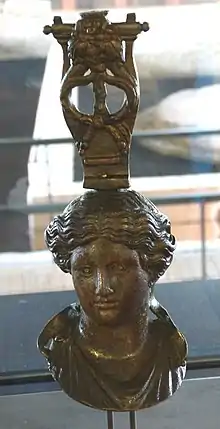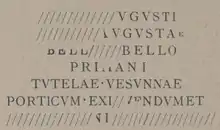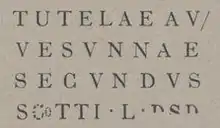Vesunna
Vesunna is a Celtic goddess worshipped in Roman Gaul. She was likely considered a giver of prosperity, abundance and good fortune, as evidenced by the cornucopia she is depicted carrying in her images.[1][2][3][4]

Vesunna was also once the name of a town just south of the modern French city of Périgueux, where the goddess had a temple in ancient times; she was certainly the patron goddess of this city and its people and thus a protector.

In inscriptions found in Périgueux, Vesunna is identified with the Roman guardian goddess Tutela. Vesunna received votive and dedicatory offerings from her worshippers; otherwise little is known of the specifics of her cult. She had a temple in the city that bore her name. Vesunna was worshipped especially by the Gaulish Celtic tribe known as the Petrocorii, whose name survives in that of the modern French city of Périgueux, located just north of her great temple.
Etymology

Vesunna's name is likely to derive from the Proto-Celtic *wesu, meaning ‘good’, 'worthy'.[5]
Alternatively, related to the name of the Greek goddess Hestia, whose name means "hearth, fireplace, altar",[6] This stems from the PIE root *wes, "burn" (ult. from *h₂wes- "dwell, pass the night, stay").[7][8][9] And so likely also related to the name of the Latin goddess of the hearth, Vesta, though this connection is questioned by Beekes.[10]
Probably related to Umbrian Vesune which should be a dative singular of a *Vesuna, presumed to be a name of a goddess. Perhaps also related to the name of Mount Vesuvius.[11]
The theonym is the direct heir to another goddess of the same city of Sianna, and derives from vesannus, -a, -um - ‘cruel, furious, excited, unstoppable’ for Sianna as a definition relative to the mistress of wildlife and as a goddess of the hunt.
Vesunna is also called Tutela, indicating her role as a patron and defender of the city.[12]
Similar theonymes
There is one inscription from Baden-Baden with the invocation of goddess Visuna, probably an inscriptive variant of goddess Vesunna from Périgueux. On the altar stone are clearly visible the objects for libation. CIL 13, 11714 = Wagner-01, p 20 = AE 1907, 00110 dating: 101 to 250 EDCS-ID: EDCS-12600015 province: Germania superior place: Baden-Baden / Aquae Visunae / L(ucius) Salvius / Similis S(alvi) / Similis / fil(ius) Medi/omat(ricus) / v(otum) s(olvit) l(ibens) m(erito)
References
- Penisson, Elisabeth (2008). Vesunna. The Gallo-Roman Museum in Perigueux. France: Editions Sud Ouest. ISBN 978-2-87901-903-1.
- Gaffiot, Félix (1934) Dictionnaire Illustré Latin-Français, Hachette
- William Smith, editor (1854, 1857) Dictionary of Greek and Roman Geography, volume 1 & 2, London: Walton and Maberly
- Henry François Athanase Wlgrin de Taillefer (1821–1826). Antiquités de Vésone, cité gauloise remplacée par la ville actuelle de Périgueux, ou description des monumens religieux, civils et militaires de cette antique cité et de son territoire, précédée d'un essai sur les Gaulois. Vol. 1. Périgueux: chez F. Dupont. pp. 502, 505.
- Matasovic, Ranko. Etymological Dictionary Of Proto Celtic. Leiden, The Netherlands: Brill. 2009. p. 418. ISBN 978-90-04-17336-1
- R. S. P. Beekes. Etymological Dictionary of Greek, Brill, 2009, p. 471.
- Calvert Watkins, "wes-", in: The American Heritage Dictionary of Indo-European Roots. Houghton Mifflin Harcourt, Boston 1985 (web archive).
- Mallory, J. P.; Adams, D. Q. (2006-08-24). The Oxford Introduction to Proto-Indo-European and the Proto-Indo-European World. OUP Oxford. p. 220. ISBN 978-0-19-928791-8.
- West, M. L. (2007-05-24). Indo-European Poetry and Myth. OUP Oxford. p. 145. ISBN 978-0-19-928075-9.
- Beekes 2010, pp. 471–472.
- Poultney, J.W. "Bronze Tables of Iguvium" 1959 p. 331 https://archive.org/details/bronzetablesofig00poul/page/n19/mode/2up
- Georgieff, Dimitar (26 July 2017). "Identity of the local pair of deities Telo and Sianna with Apollo and Diana on the territory of Roman Gaul" – via ResearchGate.
{{cite journal}}: Cite journal requires|journal=(help)